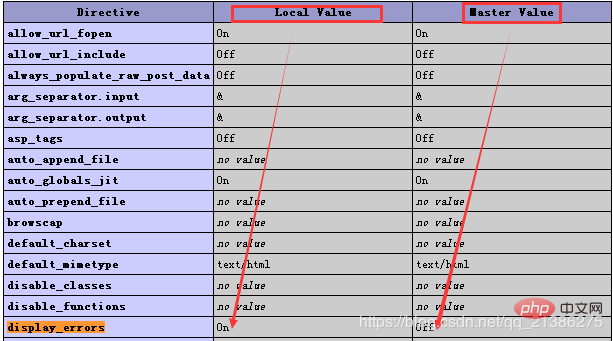 Backend Development
Backend Development
 PHP Problem
PHP Problem
 What to do if modifying php.ini does not take effect under Linux
What to do if modifying php.ini does not take effect under Linux
What to do if modifying php.ini does not take effect under Linux
The solution for php.ini not taking effect: first reload the php.ini file and print out "phpinfo();"; then search for the modified configuration; then check the "php-fpm.conf" configuration file; Finally, modify the configuration of "php-fpm".

The main reasons why php.ini modification does not take effect are as follows:
1. After modifying the php.ini configuration file, php is not reloaded. ini configuration file.
2. There are multiple php.ini configuration files
3. The configuration in php.ini is overwritten by the configuration in other files
Problem troubleshooting:
1. After modifying the configuration, reload php.ini file, print out phpinfo(); Check which configuration file is read, and make sure the configuration file you modified is correct. As shown below. 
2. Search for the configuration you modified in the printed phpinfo();. Pay attention to Local Value (local variable) and Master Value (main variable). Local Value will Override the value of Master Value. Master Value is the value of your php.ini configuration item, and Local Value may be the value set in the code, as shown below, eg: ini_set('display_errors',true); ,
In addition, Baidu said that the settings of php.ini can be rewritten in the Apache configuration file, which may be in conf/httpd.conf or conf.d/**.conf, usually in conf. d/php.conf, but the conf.d file is not found under Windows. There may be a conf.d file under the Linux version of apache. 
3. In the Linux environment, php-fpm has not been included in php before php5.3.3. The configuration of php is basically in php.ini. In php5.3.3 and later, except in php.ini In addition to configuration, you can also configure it in php-fpm.conf, and php-fpm.conf has a higher priority than php.ini.
Check the php-fpm.conf configuration file, or whether the configuration in the php-fpm.d/.conf file covers the configuration in php.ini. The configuration example of php-fpm is as follows: php_value[ session.save_handler] = redis php_value[session.save_path] = "tcp://***.***.***.***:6379?auth=***"
For more related knowledge, please visit PHP Chinese website!
The above is the detailed content of What to do if modifying php.ini does not take effect under Linux. For more information, please follow other related articles on the PHP Chinese website!

Hot AI Tools

Undresser.AI Undress
AI-powered app for creating realistic nude photos

AI Clothes Remover
Online AI tool for removing clothes from photos.

Undress AI Tool
Undress images for free

Clothoff.io
AI clothes remover

AI Hentai Generator
Generate AI Hentai for free.

Hot Article

Hot Tools

Notepad++7.3.1
Easy-to-use and free code editor

SublimeText3 Chinese version
Chinese version, very easy to use

Zend Studio 13.0.1
Powerful PHP integrated development environment

Dreamweaver CS6
Visual web development tools

SublimeText3 Mac version
God-level code editing software (SublimeText3)

Hot Topics
 1378
1378
 52
52
 How to start nginx in Linux
Apr 14, 2025 pm 12:51 PM
How to start nginx in Linux
Apr 14, 2025 pm 12:51 PM
Steps to start Nginx in Linux: Check whether Nginx is installed. Use systemctl start nginx to start the Nginx service. Use systemctl enable nginx to enable automatic startup of Nginx at system startup. Use systemctl status nginx to verify that the startup is successful. Visit http://localhost in a web browser to view the default welcome page.
 How to check whether nginx is started
Apr 14, 2025 pm 01:03 PM
How to check whether nginx is started
Apr 14, 2025 pm 01:03 PM
How to confirm whether Nginx is started: 1. Use the command line: systemctl status nginx (Linux/Unix), netstat -ano | findstr 80 (Windows); 2. Check whether port 80 is open; 3. Check the Nginx startup message in the system log; 4. Use third-party tools, such as Nagios, Zabbix, and Icinga.
 How to start nginx server
Apr 14, 2025 pm 12:27 PM
How to start nginx server
Apr 14, 2025 pm 12:27 PM
Starting an Nginx server requires different steps according to different operating systems: Linux/Unix system: Install the Nginx package (for example, using apt-get or yum). Use systemctl to start an Nginx service (for example, sudo systemctl start nginx). Windows system: Download and install Windows binary files. Start Nginx using the nginx.exe executable (for example, nginx.exe -c conf\nginx.conf). No matter which operating system you use, you can access the server IP
 How to solve nginx403
Apr 14, 2025 am 10:33 AM
How to solve nginx403
Apr 14, 2025 am 10:33 AM
How to fix Nginx 403 Forbidden error? Check file or directory permissions; 2. Check .htaccess file; 3. Check Nginx configuration file; 4. Restart Nginx. Other possible causes include firewall rules, SELinux settings, or application issues.
 How to solve nginx304 error
Apr 14, 2025 pm 12:45 PM
How to solve nginx304 error
Apr 14, 2025 pm 12:45 PM
Answer to the question: 304 Not Modified error indicates that the browser has cached the latest resource version of the client request. Solution: 1. Clear the browser cache; 2. Disable the browser cache; 3. Configure Nginx to allow client cache; 4. Check file permissions; 5. Check file hash; 6. Disable CDN or reverse proxy cache; 7. Restart Nginx.
 How to check whether nginx is started?
Apr 14, 2025 pm 12:48 PM
How to check whether nginx is started?
Apr 14, 2025 pm 12:48 PM
In Linux, use the following command to check whether Nginx is started: systemctl status nginx judges based on the command output: If "Active: active (running)" is displayed, Nginx is started. If "Active: inactive (dead)" is displayed, Nginx is stopped.
 How to solve nginx403 error
Apr 14, 2025 pm 12:54 PM
How to solve nginx403 error
Apr 14, 2025 pm 12:54 PM
The server does not have permission to access the requested resource, resulting in a nginx 403 error. Solutions include: Check file permissions. Check the .htaccess configuration. Check nginx configuration. Configure SELinux permissions. Check the firewall rules. Troubleshoot other causes such as browser problems, server failures, or other possible errors.
 How to clean nginx error log
Apr 14, 2025 pm 12:21 PM
How to clean nginx error log
Apr 14, 2025 pm 12:21 PM
The error log is located in /var/log/nginx (Linux) or /usr/local/var/log/nginx (macOS). Use the command line to clean up the steps: 1. Back up the original log; 2. Create an empty file as a new log; 3. Restart the Nginx service. Automatic cleaning can also be used with third-party tools such as logrotate or configured.



